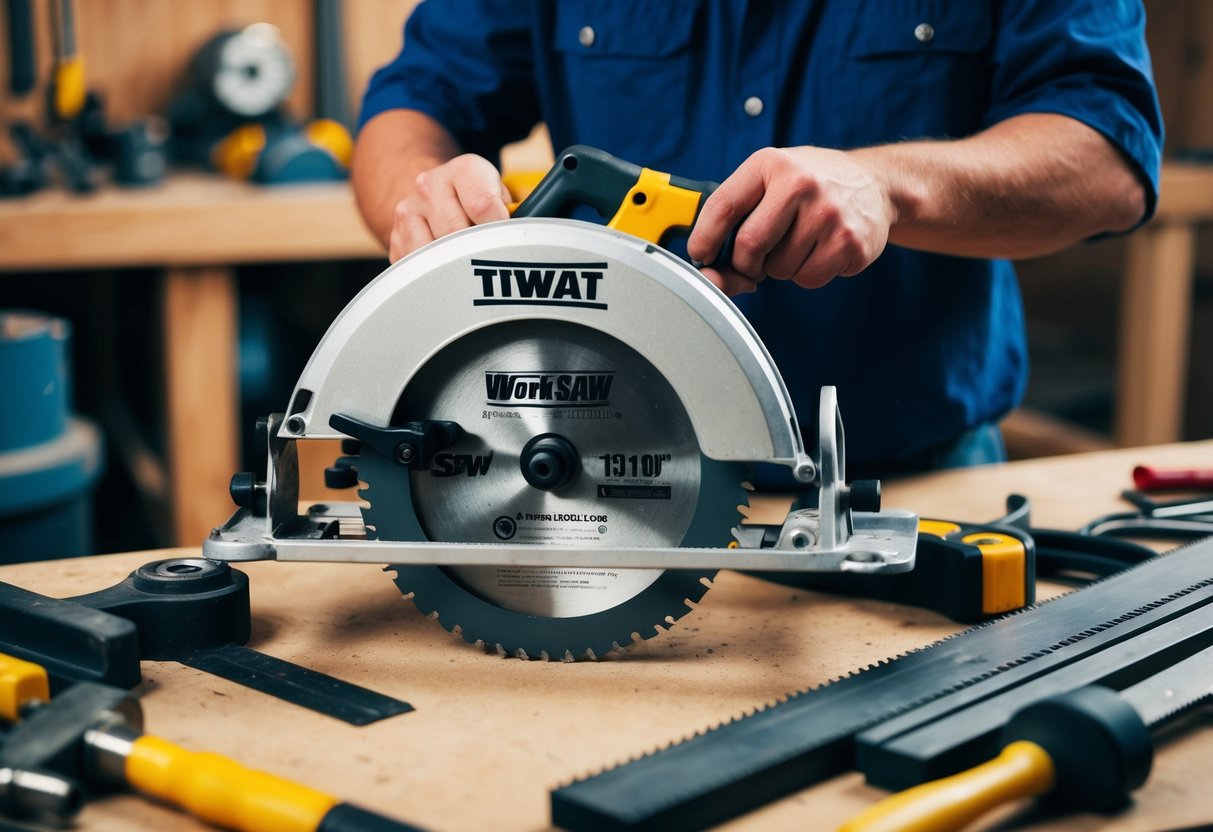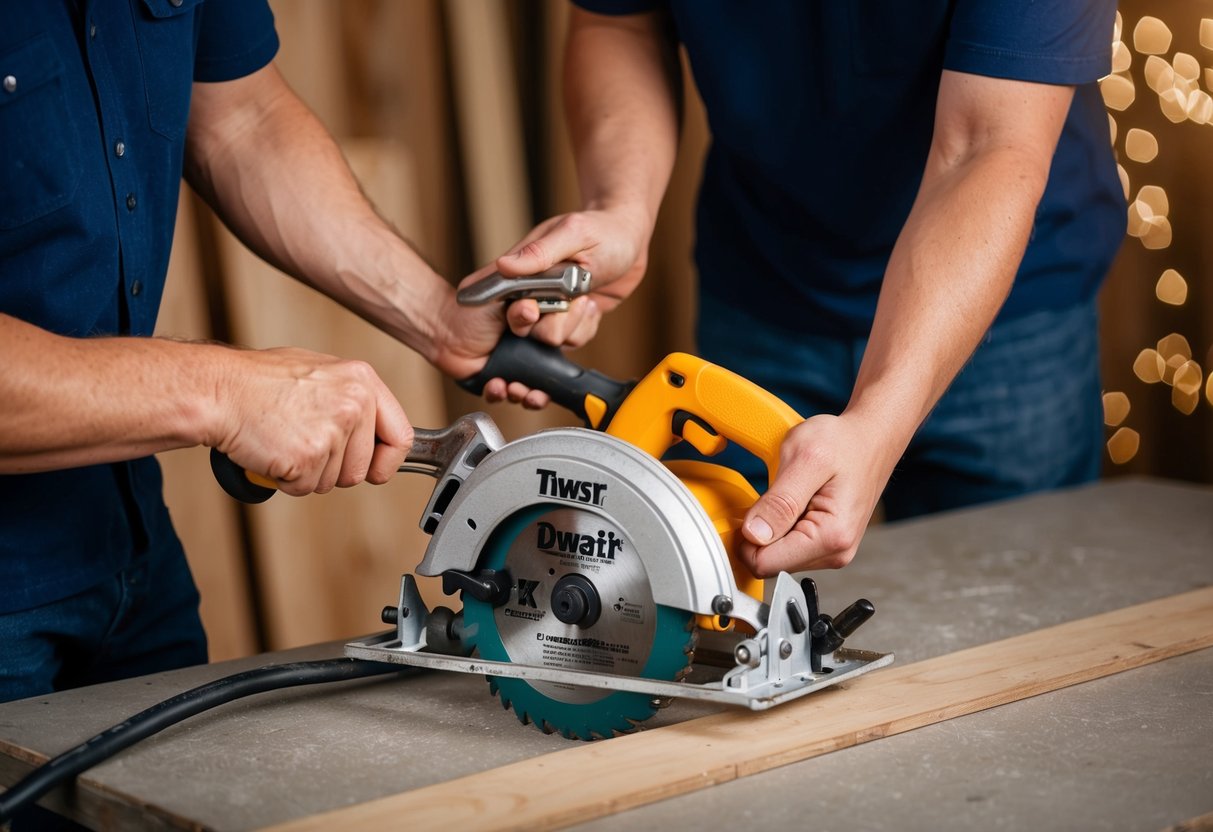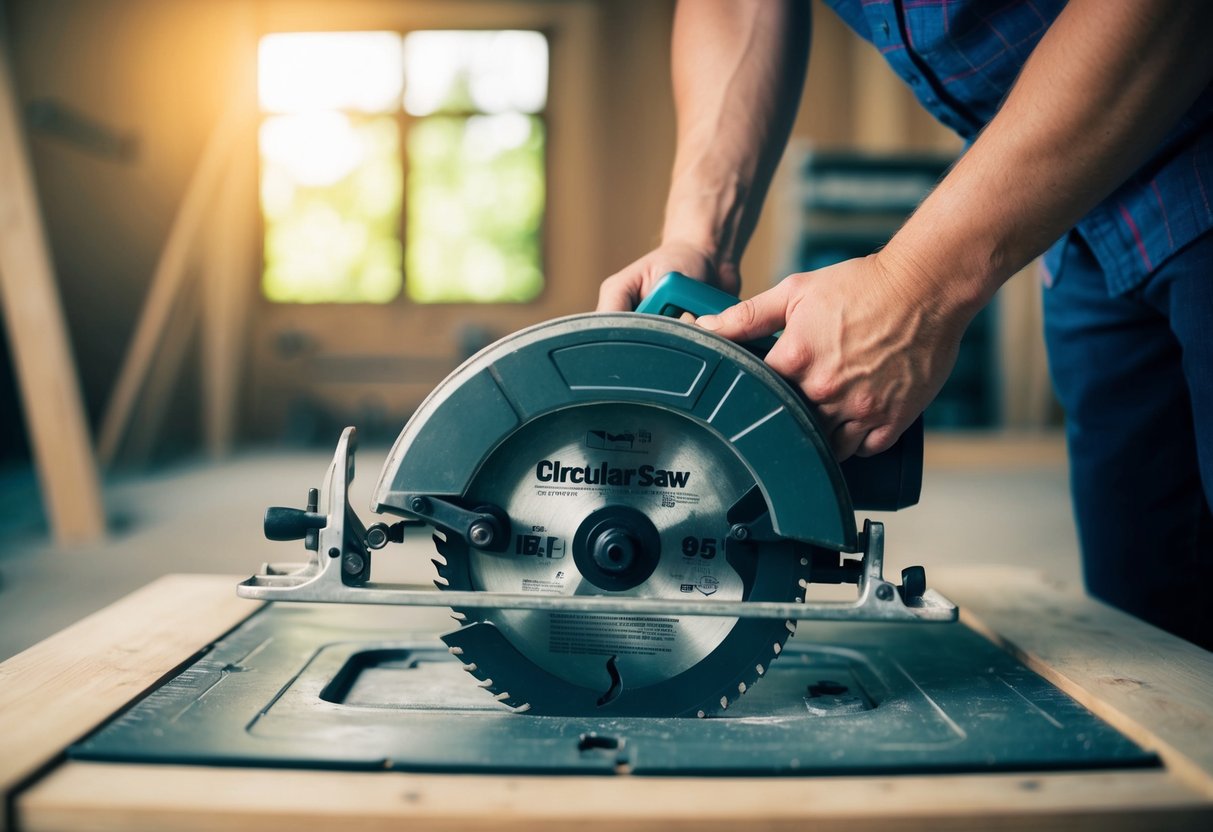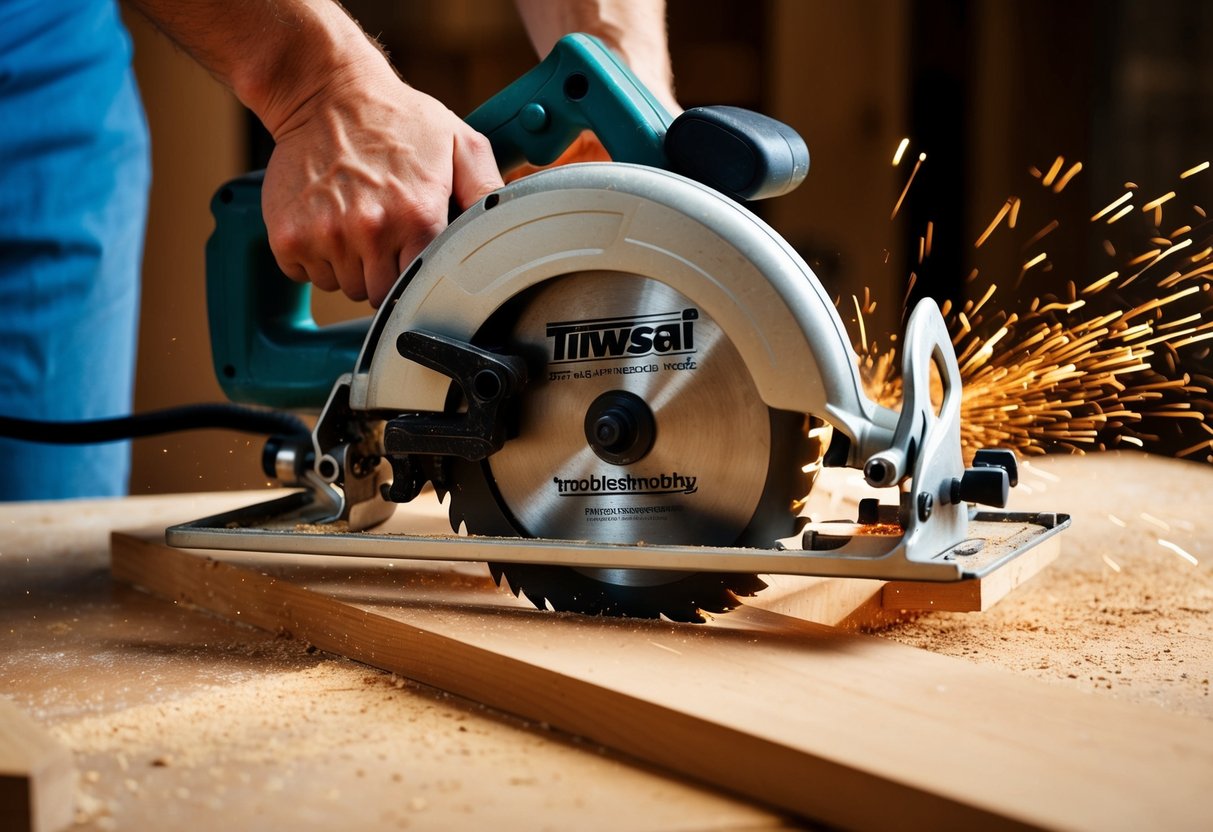Quick Solutions for Smooth Operation
Circular saws are essential tools for many DIY projects and professional jobs. But like any tool, they can sometimes have problems. When your circular saw stops working right, it can slow down your work and be frustrating.

Learning how to fix common circular saw issues can save you time and money. You can often solve many problems on your own without needing to buy a new saw or take it to a repair shop. This guide will help you troubleshoot and fix some of the most common circular saw problems.
Knowing how to fix your saw will help you get back to work faster. We’ll cover issues like blades that wobble, saws that won’t start, and cuts that aren’t straight. By the end of this guide, you’ll be better prepared to handle circular saw troubles when they come up.
Key Takeaways
- Check power sources and blade condition for many common circular saw problems
- Regular cleaning and maintenance can prevent many issues from happening
- Know when to fix issues yourself and when to get professional help for safety
Understanding Your Circular Saw
Knowing your circular saw’s parts and how to handle it properly are key to safe and effective use. These skills help you troubleshoot issues and get better results in your projects.
Key Components and Functions
A circular saw has several important parts. The blade is the main cutting tool. It spins fast to slice through wood and other materials. The motor powers the blade. The base plate helps you make straight cuts by resting flat on the work surface.
The depth adjustment lets you control how deep the blade cuts. The bevel adjustment changes the angle of the cut. The safety switch stops accidental starts. The blade guard covers the blade when not in use.
The power cord or battery provides electricity. Some models have laser guides for more precise cuts. Knowing these parts helps you use and fix your saw better.
Proper Saw Handling Techniques
Hold your circular saw with both hands for control and safety. Keep the cord away from the blade. Let the saw reach full speed before cutting. Don’t force the saw – let it move through the material at its own pace.
Make sure your work is well-supported. Use clamps to keep pieces steady. Keep the base plate flat on the work surface for straight cuts. Follow the cutting line carefully.
Wear safety gear like goggles and ear protection. Never remove guards or safety features. Unplug the saw when changing blades or making adjustments. With these tips, you’ll use your circular saw safely and get better results.
Preventive Measures and Regular Maintenance

Taking care of your circular saw helps prevent issues and keeps it running smoothly. Regular upkeep extends the life of your tool and ensures safe, accurate cuts.
Routine Inspection and Cleaning
Check your circular saw before each use. Look for loose screws, damaged cords, or worn parts. Tighten any loose components and replace damaged parts right away.
Clean your saw after every project. Use a brush to remove sawdust from the blade guard, motor vents, and base plate. Wipe down the exterior with a damp cloth.
Clean the internal components every 20-30 hours of use. Unplug the saw, remove the blade and motor housing cover. Use a dry, soft brush to clean electrical parts.
Lubricate moving parts like the blade guard and depth adjustment mechanism. Apply a small amount of machine oil to keep them working smoothly.
Blade Care and Replacement
Inspect your blade regularly for signs of wear or damage. Look for chipped, bent, or missing teeth. A dull or damaged blade can cause poor cuts and safety hazards.
Clean the blade after each use. Remove built-up resin and sawdust with a blade cleaner or solvent. This helps maintain cutting performance and prevents rust.
Replace blades when they become dull or damaged. A sharp blade cuts more efficiently and reduces strain on the motor. Choose the right blade for your material and task.
Store blades carefully to prevent damage. Use a blade storage case or hang them individually. Keep them away from moisture to prevent rust.
Diagnosing Common Circular Saw Issues
Circular saws can develop problems that affect their performance and safety. Identifying these issues quickly helps you get back to work faster and avoid potential hazards.
Power Supply and Electrical Concerns
Check your saw’s power supply first if it won’t start. Make sure it’s plugged in properly and the outlet works. For cordless saws, test the battery charge.
Inspect the power cord for damage. Look for cuts, frays, or exposed wires. A damaged cord can cause short circuits or prevent power from reaching the motor.
Worn out brushes can also stop your saw from running. These small carbon parts transfer electricity to the motor. They wear down over time and need replacement.
If you smell burning or see sparks, unplug the saw immediately. This could indicate an electrical short inside the tool. Don’t use it until a professional checks it out.
Mechanical and Cutting Problems
A wobbly or vibrating blade makes rough, inaccurate cuts. Check that the blade is tight and not bent or damaged. Replace warped or chipped blades right away.
Adjust the blade depth if your saw binds in the material. The teeth should only extend about 1/4 inch below the wood. Too deep, and the saw works harder than needed.
Clean out built-up sawdust regularly. It can clog moving parts and cause overheating. Use compressed air or a brush to clear vents and the blade area.
If your cuts aren’t straight, check the shoe plate. A bent or misaligned plate throws off your cutting line. Adjust or replace it if needed.
Troubleshooting Specific Issues

Circular saws can face various problems that disrupt your work. Let’s explore common issues and their solutions to get your saw running smoothly again.
When the Saw Motor Won’t Start
A non-starting motor is frustrating. First, check your power source. Is the battery charged or the cord plugged in? Next, examine the safety switch. It might be stuck or damaged.
If power isn’t the issue, inspect the carbon brushes. These small parts wear out over time. Look for signs of damage or excessive wear. Replacing them often solves starting problems.
Don’t forget to check the power cord for frays or cuts. A damaged cord is dangerous and can prevent the saw from starting.
Addressing Overheating Issues
Overheating can damage your saw’s motor. One common cause is a clogged air intake. Clean it regularly to prevent this issue.
Excessive sawdust buildup can also lead to overheating. After each use, clean your saw thoroughly. Pay special attention to the motor housing and vents.
Using the wrong blade or pushing the saw too hard can cause overheating. Make sure you’re using the right blade for your material. Let the saw do the work – don’t force it through the cut.
If overheating persists, let the saw cool down before use. Consider shorter work sessions with breaks in between.
Resolving Unusual Noises
Strange noises from your saw can signal problems. A grinding noise often means the blade is dull or damaged. Inspect it closely. Replace the blade if you see chips, cracks, or excessive wear.
Rattling sounds might indicate loose parts. Check all screws and bolts. Tighten any that have come loose.
A high-pitched whine could mean the motor bearings are failing. This requires professional repair in most cases.
Rectifying Blade Problems
Blade issues can lead to poor cuts and safety risks. If your blade wobbles or vibrates, it might be warped. Replace it immediately.
Dull blades cause rough cuts and put extra strain on the motor. Sharpen or replace dull blades promptly.
Make sure your blade is installed correctly. A backwards blade won’t cut effectively and can be dangerous. Double-check the arrow on the blade matches the saw’s rotation direction.
Saw Stopping during Operation
If your saw keeps stopping mid-cut, several issues could be at play. A damaged or warped blade is a common culprit. Inspect your blade carefully and replace if needed.
Low power can also cause stopping. For corded saws, check your extension cord. It might be too long or thin for your saw’s power needs. For cordless models, ensure your battery is fully charged.
Overheating can trigger automatic shut-offs in some models. If your saw feels hot, let it cool before continuing.
Remember, if you can’t identify or fix the problem, it’s best to seek professional help. Safety should always be your top priority when working with power tools.
When to Seek Professional Help

Sometimes circular saw issues are too complex for DIY repairs. You should get professional help if your saw has electrical problems or makes strange noises. Experts can diagnose and fix issues safely.
Check your saw’s warranty before seeking repairs. Many manufacturers offer free repairs or replacements for defective parts within the warranty period. Contact the company’s customer service for guidance.
Here are signs you need professional help:
• Sparks or smoke coming from the motor • Severe vibration that persists after blade replacement • Electrical cord damage • Motor overheating frequently
Don’t try to fix these issues yourself. Attempting repairs can void your warranty and be dangerous.
To find a reputable repair service:
- Ask for recommendations from other woodworkers
- Check online reviews
- Contact the saw manufacturer for authorized service centers
Professional repairs may cost $50-$200 depending on the issue. For older or cheaper saws, buying a new one might be more cost-effective than extensive repairs.
Remember, safety comes first. If you’re unsure about fixing a problem, it’s best to consult a professional. They have the tools and know-how to get your saw running smoothly again.
Optimizing Saw Performance

Proper blade selection and ensuring precise cuts are key to getting the most out of your circular saw. These factors greatly impact the quality and efficiency of your woodworking projects.
Correct Blade Selection for Various Materials
Choosing the right blade for your project is crucial. For softwoods, use a blade with fewer teeth (24-40) for faster cuts. Hardwoods need more teeth (60-80) for smoother finishes. Plywood requires even more teeth (80+) to prevent tear-out.
Sharp blades are essential for optimal performance. Replace dull blades promptly to avoid burning wood or straining the motor. Consider blade coatings for specific materials – carbide-tipped for general use, diamond-tipped for tile or concrete.
Match blade size to your saw. Most circular saws use 7 1/4″ blades, but always check your model’s specifications. Using the wrong size can be dangerous and ineffective.
Ensuring Precise and Straight Cuts
To achieve straight cuts, use a guide rail or straightedge. Clamp it securely to your workpiece. Adjust your saw’s depth so the blade extends about 1/4″ below the material for clean cuts and reduced kickback risk.
Check your saw’s baseplate for squareness. A misaligned blade can cause crooked cuts. Adjust if needed following your saw’s manual.
Support your workpiece properly to prevent binding. Use sawhorses or a sturdy work surface. For long cuts, have a helper support the off-cut piece.
Mark your cut line clearly and keep the saw’s guide notch aligned with it. Move the saw steadily, letting the blade do the work without forcing it. This approach helps you make accurate cuts and extends blade life.
Frequently Asked Questions
Circular saws can face various issues that stop them from working properly. These problems range from the saw stopping mid-cut to blades not spinning. Let’s address some common questions and their solutions.
Why does my circular saw stop during a cut?
Your circular saw might stop during a cut due to overheating or power issues. Check the power cord for damage. Make sure the saw isn’t overworked. Give it breaks between cuts to cool down.
Clean out any sawdust buildup. This can clog the motor and cause it to stop. Regular cleaning helps prevent this problem.
What should I check if my DeWalt circular saw stopped working?
First, check the power source. Make sure the battery is charged or the cord is plugged in. Look at the blade. A loose or damaged blade can cause the saw to stop.
Check the motor brushes. Worn brushes can prevent the saw from running. Replace them if needed. If these steps don’t work, the motor might need repair.
How can I fix a circular saw that’s not cutting all the way through a 2×4?
Check the blade depth setting. It might be set too shallow. Adjust it so the blade extends about 1/4 inch below the wood.
Make sure you’re using the right blade for the job. A dull or wrong-type blade won’t cut well. Replace it with a sharp blade meant for cutting 2x4s.
What could be causing my circular saw blade to not spin?
A blade that won’t spin could be jammed with debris. Unplug the saw and clean around the blade. Check if the blade lock is engaged. This safety feature stops the blade from spinning.
The motor might be broken if these aren’t the issue. In this case, you’ll need to get it repaired or replaced.
How do I perform essential maintenance on a circular saw?
Clean your saw after each use. Remove sawdust with a brush or compressed air. Check the blade regularly for damage or dullness. Replace it when needed.
Lubricate moving parts as directed in your saw’s manual. Check and tighten any loose screws or bolts. Keep the power cord or battery connections clean and undamaged.
What is the function of a lock-off switch on a circular saw?
The lock-off switch is a safety feature. It prevents the saw from starting accidentally. You need to press this switch before you can pull the trigger to start the saw.
This feature is especially useful when carrying or storing the saw. It reduces the risk of injury from unintended starts.




